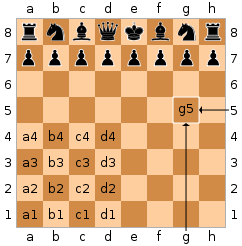Appendix:Algebraic notation
The algebraic notation is a method for recording and describing the moves in a game of chess.
Naming the squares
[edit]
Each square of the chessboard is identified by a unique coordinate pair—a letter and a number.
Letters are files (vertical columns) from a to h, from queenside (white's left) to kingside (white's right).
Numbers are ranks (horizontal rows) from 1 to 8, from white's side of the board.
- a1 is the first file, first rank (which is the starting position for a white tower)
- d4 is one of the four middle squares
Naming the pieces
[edit]
Each piece, except the pawn, is identified by an uppercase letter. The pawn is rather identified by the absence of a letter.
- K – king
- Q – queen
- R – rook
- B – bishop
- N – knight (since K is already used)
- absence of a letter – pawn
Languages other than English may employ different letters.
Notation for moves
[edit]Each move of a piece is indicated by the piece's uppercase letter, plus the coordinate of the destination square.
- Be5 (move a bishop to e5)
- Nf3 (move a knight to f3)
- c5 (move a pawn to c5—no piece letter in the case of pawn moves)
Capture
[edit]If it's a capture, an "x" is inserted immediately before the destination square. When a pawn makes the capture, the file from which the pawn departed is used to identify the pawn.
- Bxe5 (bishop captures the piece on e5)
- exd5 (pawn on the e-file captures the piece on d5)
In case of en passant, the destination square is specified (not the square of the captured pawn) and, optionally, the suffix e.p. is added.
- exd6e.p. (pawn on the e-file goes to square d6, capturing en passant)
Disambiguating moves
[edit]When two or more identical pieces can move to the same square, the piece's letter is followed by: the file of departure (if they differ), the rank of departure (if the files are the same but the ranks differ) or both the file and the rank (if neither alone is sufficient to identify the piece—which occurs only in rare cases where one or more pawns have promoted, resulting in a player having three or more identical pieces able to reach the same square).
- Ngf3 or Ndf3 (for example, with knights on g1 and d2, either of which might move to f3, the move is specified as Ngf3 or Ndf3, as appropriate)
Promotion
[edit]When a pawn moves to the last rank and promotes, the piece promoted to is indicated at the end of the move notation. Sometimes. an equals sign (=) or parentheses are used.
- e8Q, e8=Q or e8(Q) (pawn promotion to queen)
Castling
[edit]Castling is either 0-0 (for kingside castling) or 0-0-0 (queenside castling).
While the FIDE Handbook, appendix C.13 uses the digit zero (0-0 and 0-0-0), PGN requires the uppercase letter O (O-O and O-O-O).
Check and checkmate
[edit]Usually, these symbols identify check and checkmate:
- + – check
- # – checkmate
Sometimes, these others are seen:
- a dagger (†) – check
- a double dagger (‡) – checkmate
- the abbreviation "ch" – check
- dlb ch – double check
- the word mate – checkmate
End of game
[edit]These notes at the completion of moves indicates who won:
- 1–0 – white won
- 0–1 – Black won
- ½–½ – a draw
Series of moves
[edit]A game or series of moves is generally written in one of two ways.
- In two columns, as White/Black pairs, preceded by the move number and a period:
- 1. e4 e5
- 2. Nf3 Nc6
- 3. Bb5 a6
- As horizontal text:
- 1. e4 e5 2. Nf3 Nc6 3. Bb5 a6
Moves may be interspersed with commentary (annotations). When the score resumes with a Black move, an ellipsis (...) fills the position of the White move, for example:
- 1. e4 e5 2. Nf3
- White attacks the black e-pawn.
- 2... Nc6
- Black defends and develops simultaneously.
- 3. Bb5
- White plays the Ruy Lopez.
- 3... a6
- Black elects Morphy's Defence.
Annotation symbols
[edit]Though not technically a part of algebraic notation, the following are some common symbols frequently used by annotators to give evaluative comment on a move:
- ! (a particularly good—and usually surprising—move)
- !! (an excellent move)
- ? (a bad move)
- ?? (a blunder)
- !? (an interesting move that may not be best)
- ?! (a dubious move – one which may turn out to be bad)
Variations
[edit]Some variations apply, such as using a colon in place of x to identify a capture (B:e5 rather than Bxe5), or using symbols in place of uppercase letters (♞c6 rather than Nc6).
